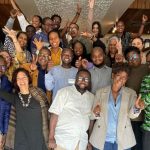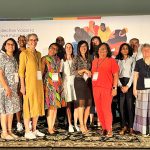
GT4Africa Cohort Writing Workshop Report
4 June 2025
SALAD Reignites Passion for the District Health System at PHASA 2025
20 June 2025
Intersectionality and sexual, reproductive and maternal health in Africa: Discussions from the gender transformation for Africa collaborative
As a collaboration of six implementation research grants on gender transformative approaches to sexual, reproductive and maternal health across Africa, we convened a conversation to discuss how intersectionality applied to our work.
Intersectionality was coined by Professor Kimberlé Crenshaw in 1989 reflecting on how gender or race alone did not reflect black women’s experiences with racism and sexism in a combined manner. Similar concerns about how race, class and other forms of social discrimination combine with gender discrimination have also been raised by feminists in Africa and South Asia, although not necessarily using that term.
Intersectionality views human experience as being shaped by how different forms of social advantage or disadvantage combine (e.g., ‘race’/ ethnicity, indigeneity, gender, class, sexuality, geography, age, disability/ability, migration status, religion), rather than being experienced independently from each other. These social forces are not seen as identities, but rather shaped by structural drivers (e.g., laws, policies, social and organisational norms, religious institutions, media). In essence, intersectionality is a lens through which one can see where power comes from and how it shapes gender privilege and prejudice in social systems in dynamic and context specific ways. Individuals, with different advantages and disadvantages, navigate these systems, which are always open to change given that they are shaped by human decisions.
An intersectionality lens makes a difference to:
- How the research “problem” (or question) is defined and the nature of the conceptual framework used:
- by going beyond defining the research population in terms of single categories and recognising the complexity of social discrimination. Acknowledging that within a group not all individuals are the same and that a person/ group can experience advantages and disadvantages simultaneously.
- moving beyond individual behaviours to draw attention to the factors driving inequalities and that these factors operate at multiple levels beyond individual experiences of discrimination
- How the research is carried out, including how the research is disseminated and/or used in praxis
- focussing on varied lived experiences of marginalisation and the drivers of advantage/ disadvantage;
- using a range of methods to better capture the complexity involved;
- being reflexive about the power relationships in the team and between team and participants
- using findings to raise consciousness among affected groups;
- drawing public attention to and fostering policy advocacy and practice that address the inequalities identified
Prevention of unwanted pregnancy as a result of transactional sex was one among a few examples discussed by webinar participants.
- What is an intersectionality informed question on prevention of unwanted pregnancy? How does it shape your research problem and conceptual framework?
Intersectional questions shape how the research problem is defined. They explore context based vulnerability and agency, i.e. advantages and disadvantages structured by different kinds of power inequalities that vary by context and can change over time.
For example, unwanted teenage pregnancy in some contexts is linked to transactional sex, ie where sex is used to gain access to resources. It is usually older men who have sex with adolescent girls for sex in exchange for material goods.
Addressing the above research topic using intersectionality will mean unpacking the varying degrees of agency and vulnerability across different groups of adolescent girls located across a hierarchy of stratifiers: poor/non-poor, rural/urban, married/unmarried. Between the two extremes in terms of vulnerability, i.e. poor, belonging to a marginalised community, living with disability at one end and non-poor, from a dominant community and without disability, there are many social locations that combine advantages and disadvantages.
Forms of gender and age discrimination may be acute for rural, unmarried younger girls. However, urban girls who are poor may be more aware of relative deprivation and can purchase material goods if they gain access to resources to do so, and therefore may be more vulnerable to transactional sex. Intersectionality helps us not to assume that all forms of disadvantage or advantage act in the same direction, i.e. there may be unexpected patterns as different forms of social advantage and disadvantage interact with one another.
Initially group discussions framed questions that focussed on young girls and understanding the factors that lead to vulnerability of young girls and how they exercise “their agency” to engage in transactional sex. An intersectional approach to defining research problems would also look more holistically at the actors and power relationships involved. The questions that arose focussed on the denial of contraceptive information and services by healthcare providers and decisions by families and schools to not provide sexuality education. The group moved from focussing solely on adolescent girls and also began to ask what are the factors that enable older men’s engagement in transactional sex? How their relational power over younger women, marginalises those women. How do we understand them from an intersectional lens? Which men in particular can exercise such power and why?
Using an intersectional approach, the question broadened to What are the pathways through which transactional sex results in an unwanted pregnancy? This allows for examining the broader structural factors underpinning the behaviours under focus. It leads to an exploration of
- family formation and economic survival in the region;
- changing livelihood patterns;
- the role of anti-gender movements and ideologies shaping programs to promote abstinence and restrictions on sexual education;
- social norms around adolescent sexuality and pregnancy in the communities under focus;
and an exploration of how these drivers change the pathways towards or away from transactional sex and the consequences from it for different kinds of adolescent girls and boys.
- How does intersectionality shape how you do your research:
- It entails potentially expanding your sample size to include more variation across various contextually relevant social stratifiers. For example, including ethnicity or a broader set of age ranges for adolescent girls engaged in transactional sex.
- It means undertaking more formative/ exploratory research to understand the local contexts you are working in from the perspectives of diverse local actors starting with adolescent girls engaged in transactional sex themselves.
- It means having flexibility of your research plans to change focus to factors unearthed to be more significant than previously anticipated.
- It means iterative forms of measurement over time to capture non-linear change more accurately.
- Having more time to explore ways in which the voices and lived experiences of research participants are given salience
- Partnering with local actors to use the evidence generated to support programmatic or policy change.
